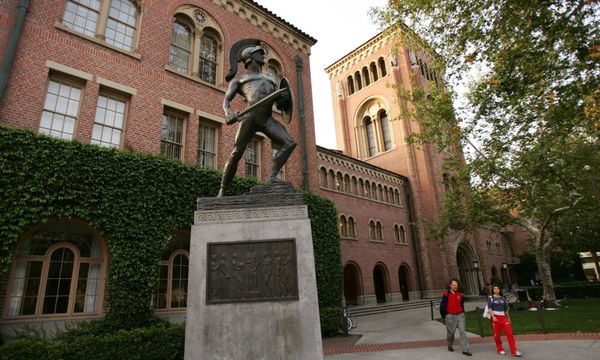
In 1966, the artist Brice Marden, who has died of cancer aged 84, exhibited a canvas called The Dylan Painting in his first solo show, at the Bykert Gallery in New York. Six years earlier, Marden had married Pauline Baez, older sister of the singer Joan. Through his sister-in-law, he met a young Greenwich Village folk musician called Bob Zimmerman, and found him “a fantastic guy”.
It was 1962. “I had wanted to make a painting for him, to put out into the world to help his career,” Marden recalled in an interview for the San Francisco Museum of Modern Art in 2015. “By the time I got this painting finished, Bob [Dylan] was, like, very, very famous. He didn’t need my help.”
This was not the work’s only mis-timing. The Dylan Painting, now in the collection of SFMoMA, is a plum-coloured monochrome, 153cm x 307cm. It is made in encaustic, a mixture of oil paint and beeswax applied by the artist with a kitchen spatula: Marden had learned the technique while working as a guard at a Jasper Johns retrospective at New York’s Jewish Museum in 1964.

The Dylan Painting, though, has nothing to do with Johns’s proto-pop paintings of flags, targets and numbers. Its feel is much closer to the saturated canvases of Mark Rothko, although Rothko was a generation older than Marden and the school of painting to which he belonged – abstract expressionism – had, by 1966, been declared officially dead.
Nonetheless, Marden persisted, shunning the various forms of post-painterly abstraction then fashionable in New York to make works whose aim was the old-fashioned one of calling up the sublime. His paintings changed by increments, setting up their own internal systems – “lots of rules, yet no rules”, as Marden put it – and then moving on.
By 1970, he was painting canvases such as Made for Pearl, of adjoining panels of colours that both collaborated and subtly clashed. After studying at Boston University, where he had met and in 1960 married Pauline Baez, Marden had won a scholarship, in 1961, to do a master’s at Yale. Although he claimed not to have understood anything of the course he took there with the former Bauhaus master, Josef Albers, Albers’s teachings on the interaction of colour would seem to have left their mark.
The combination in Marden’s art of constant experimentation and resistance to fashion soon won him a following. By 1975, the New York Times critic, Hilton Kramer, could write of “younger painters, scarcely out of school, taking his work as a model”. That same year, the 37-year-old Marden was given a career retrospective at the Guggenheim.

Two years later, he beat off Johns, Roy Lichtenstein and Joseph Beuys to win a commission to design stained glass windows for the apse of the minster church of Basel in Switzerland. Although these were never made, in the resulting Basel Window study series, painted between 1978 and 1985, Marden’s palette changed from the subdued minimalism of his earlier work to a more vivid one, shaped by a new set of compositional devices taken from architecture.
It was a trip to the far east in 1983 and a visit to an exhibition of Japanese calligraphy in New York the following year that brought about a change in Marden’s work. He began to make large ink drawings using sticks, some of them two metres long, which he collected from the ailanthus trees outside his Greenwich Village studio. With these, he drew skeins of loops, their organisation based broadly on the arrangement of characters and couplets of Chinese poetry.
As well as drawings and etchings, this gave rise to what remains Marden’s most famous series of canvases, the so-called Cold Mountain paintings (1989-91), their title taken from the literal translation of the name of Han Shan, the Tang dynasty poet whose work had inspired them. For these, the artist used unwieldy, metre-long brushes, playing accident off against control to loosen up his composition. A work such as SFMoMA’s Cold Mountain 6 (Bridge), with its strong foreground calligraphic pattern echoed by a ghostly grey one behind, suggests the whirled surfaces of Jackson Pollock.

The vermiculate line became a trademark of Marden’s painting for the rest of his life, but it did not become a restriction. His later work was marked by a new palette drawn from nature, and in particular that of the American north-east in which he had grown up. The middle of three children of Nicholas Marden, a mortgage broker, and Kathryn (nee Fox), Brice had been born and raised in upstate New York. His childhood was spent in the village of Briarcliff Manor, looking down on the Hudson River.
“As long as I remember, we lived in the same house,” he said in a 1972 interview for the Archives of American Art. In a field behind that house, he had, at 13, what he later saw as a revelation. “I fell asleep and woke up lying in these reindeer ferns,” Marden recalled. “It just seemed to me that when I woke up, I was different than when I went to sleep. I always took that as the point that I became an artist.”
For all that, his first plan was to be a hotelier. “I’d applied to all these hotel administration schools,” Marden remembered. “And then I said I don’t want to do that, I said I wanted to study art. My family was really largely upset.” Many years later he and his second wife bought a hotel on the Caribbean island of Nevis and opened a village inn in Tivoli, New York state.
These were in addition to the artist’s Manhattan studio, a 400-acre farm in Pennsylvania, a house on the Greek island of Hydra and the estate, called Rose Hill, overlooking the Hudson at Tivoli. His work fetched the kind of stratospheric sums normally associated with old masters. In 2020, one canvas, Complements (2004-07), sold at auction for £25m, just short of the highest price ever paid for a Rembrandt.

In 2018, his largest painting, a five-panel work called Moss Sutra With the Seasons, was hung in its own chapel-like space at a private gallery in Maryland. Typically, it had taken Marden five years to complete. “The first colour down on this ground of spring is the colour from winter, which is the preceding panel, and then the first colour on the summer is the colour of the spring,” he explained to an interviewer in 2012, when the work was half finished. “I have to figure out where do I take it from here.”
In the year Moss Sutra was installed in its gallery, Marden was diagnosed with cancer. “I was afraid that [work] might have been my last, it had taken so long,” he told the New York Times. He then set off on the new series of canvases, made in a green earth pigment called terre verte, on which he was still working when he died.
Marden is survived by his second wife, Helen Harrington, whom he married in 1968, and their daughters, Mirabelle and Melia; and by Nicholas, the son of his marriage to Pauline Baez, which ended in divorce in 1964.
• (Nicholas) Brice Marden, painter, born 15 October 1938; died 9 August 2023







